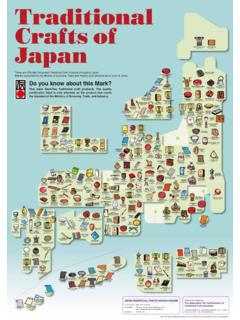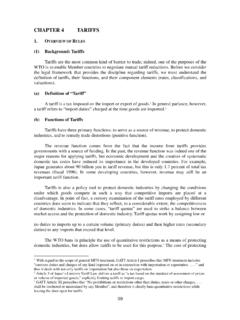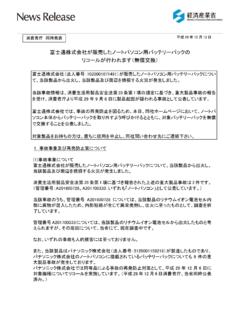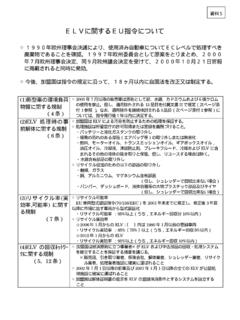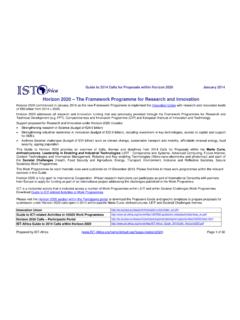Transcription of New Robot Strategy - Minister of Economy, Trade and Industry
1 New Robot Strategy Japan s Robot Strategy - Vision, Strategy , Action Plan - The Headquarters for Japan s Economic Revitalization 10/2/2015 1 Part I General Statement .. 2 Chapter 1 Prologue .. 2 Section 1 Current situation surrounding Japan as a robotics superpower .. 2 Section 2 Drastic transformation of robots and Japan s future .. 4 Section 3 Goal of Robot revolution .. 7 Chapter 2 Measures for realization of Robot revolution ..11 Section 1 Robot creativity Thorough reinforcement of robots in Japan .11 Section 2 Utilization and popularization of robots Daily life with robots across Japan .. 13 Section 3 Development and progress of Robot revolution on global perspectives Toward new advanced IT society .. 16 Part II Action Plan: Five-year Plan.
2 18 Chapter 1 Cross-Cutting Issues .. 18 Section 1 Establishment of " Robot Revolution Initiative (RRI)" .. 18 Section 2 Technology development toward the next generation .. 20 Section 3 Policy on the Global Standardization of Robotics .. 27 Section 4 Field-Testing of Robots .. 35 Section 5 Human Resource Development .. 38 Section 6 Implementation of Robot Regulatory Reform .. 41 Section 7 Expansion of Robot Award .. 46 Section 8 Consideration of Robot Olympic (Provisional Name) .. 48 Chapter 2 Particulars by Sector .. 51 Section 1 Manufacturing Sector .. 51 Section 2 Service fields .. 58 Section 3 Nursing and medical fields .. 63 Section 4 Infrastructure, disaster response, and construction fields .. 71 Section 5 Agriculture, Forestry, Fishery, and Food Industry .. 77 2 Part I General Statement Chapter 1 Prologue Section 1 Current situation surrounding Japan as a robotics superpower Subsection 1 Japan as a robotics superpower Robots have become rapidly common in Japan since the 1980 s primarily in the manufacturing sector.
3 In particular, the automobile, electric and electronic industries showed a significant growth against the backdrop of greater labor productivity in line with the full-fledged employment of robots as the major destination for supply of robots. It goes without saying that these industries have played an active role for Japan to usher in an era of Japan as No. 1 driven indeed by the utilization of robots. In addition, robots have always been in the spotlight in Japan for diverse potentials and there have been noteworthy innovative achievements such as pet-like robots aiming to provide comfort and surprise to human or world-leading research and development on human-shaped robots and study of service robots. Japan s excellence in the field of robotics has particularly been notable in the area of industrial robots which have been employed ahead of others.
4 Japan has maintained its global position as the world s number one supplier of industrial robots in value, and also tops in the number of units in operation till present. As of 2012, Japan earned the shipment value of about JPY340 billion which accounts for approximately 50% of the global share as well as the number of units in operation (based on stocks) of roughly 300,000 units which accounts for 23% of the global share. In addition, Japan holds great share of over 90% worldwide in the field of key Robot elements such as precision reduction gear for robots, servo motor and force sensor. As evidenced above, Japan continues to maintain its status as Robotics Superpower till present built on its world-renowned strengths in diverse areas of Robot production, utilization, supply of key parts, research and development.
5 Subsection 2 Japan as an advanced country of challenging issues Japan has been faced with the issues of declining birth rate and ageing society which are progressing at an unparalleled speed worldwide and thus Japan has become one of the first among other nations to encounter such challenges as a decline in the number of working-age population, shortage in labor and higher social security costs as a result of the issues above. Indeed the number of senior citizens aged 65 and above hit the record-high level of over million as at 1 October 2013 and their percentage against the total population (population aging rate) also marked a record 3 The number of working-age population is also on the decline and currently dips below the level of 80 million to million.
6 Social security costs hit a record trillion in the fiscal year 2012 amid such environment, accounting for 30% against the national income. In addition, there are myriad issues that require immediate systematic actions from the entire society for protection of our lives including enhanced disaster preparedness and upgrading of aged social capitals to cope with heavy rain disasters occurring more often than ever in recent years. For industries, there is no doubt about declining global competitiveness in the manufacturing sector for instance and amount of value-added production has been shrinking to the point where nearly JPY20 trillion has been lost at least in the past 20 years. There is tendency that some sectors count on overseas production for lower operation costs.
7 However from a viewpoint of maintaining and fortifying global competitiveness of the Japanese economy towards the future, enhancing domestic geographical advantage is a challenge that is as crucial as keeping pace with the expansion of overseas market. To meet these challenges, advancing reform of the socioeconomic system is of course indispensable, and further initiatives must also be taken by gathering all knowledge and expertise available including utilization of new technical innovation. Subsection 3 Catch-up of other countries by the Robot as a key to growth Robots are back in the limelight once again in recent years as the key to growth across the world including both developed countries like Europe and America as well as emerging economies represented by China.
8 The US government released the National Robotics Initiative in 2011 providing tens of millions of dollars every year to support fundamental research on robots mainly in the fields of Artificial Intelligence (AI) and recognition (voice, image etc). In addition, Google, a major IT enterprise originating from US, drew global attention last December when it bought over seven venture companies one after another (worth USD60 million) to obtain promising Robot technologies possessed by these companies. Among the seven acquired companies is one of the top players in DARPA Robotics Challenge held by the Defense Advanced Research Projects Agency (DARPA) of the United States Department of Defense since 2012. In Europe, the EU SPARC Project was launched in 2014 as a research and innovation project in the field of robotics through collaboration between the European Commission and around 180 private companies and research bodies in order to go ahead with the development of practical robots for use in the manufacturing, agricultural, health and hygiene, transportation, civil social security and household sectors.
9 As part of the overall 4 initiatives there is a project worth billion in total through investments of approximately EUR700 million from the European Commission and billion from private companies and research bodies. Key highlight of these movements in Europe is the transformation of society where physical objects are interconnected through network which is called Internet of Things (IoT1) has become more realistic in line with the rapid progress of digitalization as well as advancement of network and cloud technologies. Countries in Europe and America are seemingly aiming to win the lead in utilization of new robots by cashing in on these changes. On the other hand, China has been aggressively employing state-of-the-art industrial robots as part of the countermeasures against rising labor costs, or efforts to secure higher quality.
10 The Chinese government advocates the Development Plan for Intelligent Manufacturing Equipment Industry ( ) (2012) aiming to hit a domestic sales target for industrial robots of 3 trillion yuan by 2020 which is ten times as much as the current level. As evidence of the trend, robots have been embraced rapidly in China and the annual number of Robot units (flow) employed in 2005 of 4,000 has soared to 37,000 in 2013, beating Japan and pushing China to the top of the world. Section 2 Drastic transformation of robots and Japan s future Subsection 1 Drastic transformation of robots Amid such environment, robots have started to make drastic transformation themselves along with technology innovation and changes in business models. The very first change is that robots are shifting themselves from those doing simple routine tasks to autonomous ones equipped with self-learning abilities and action initiatives.


